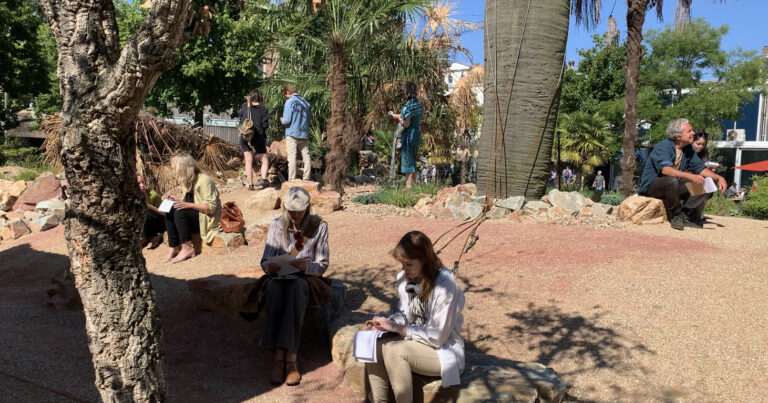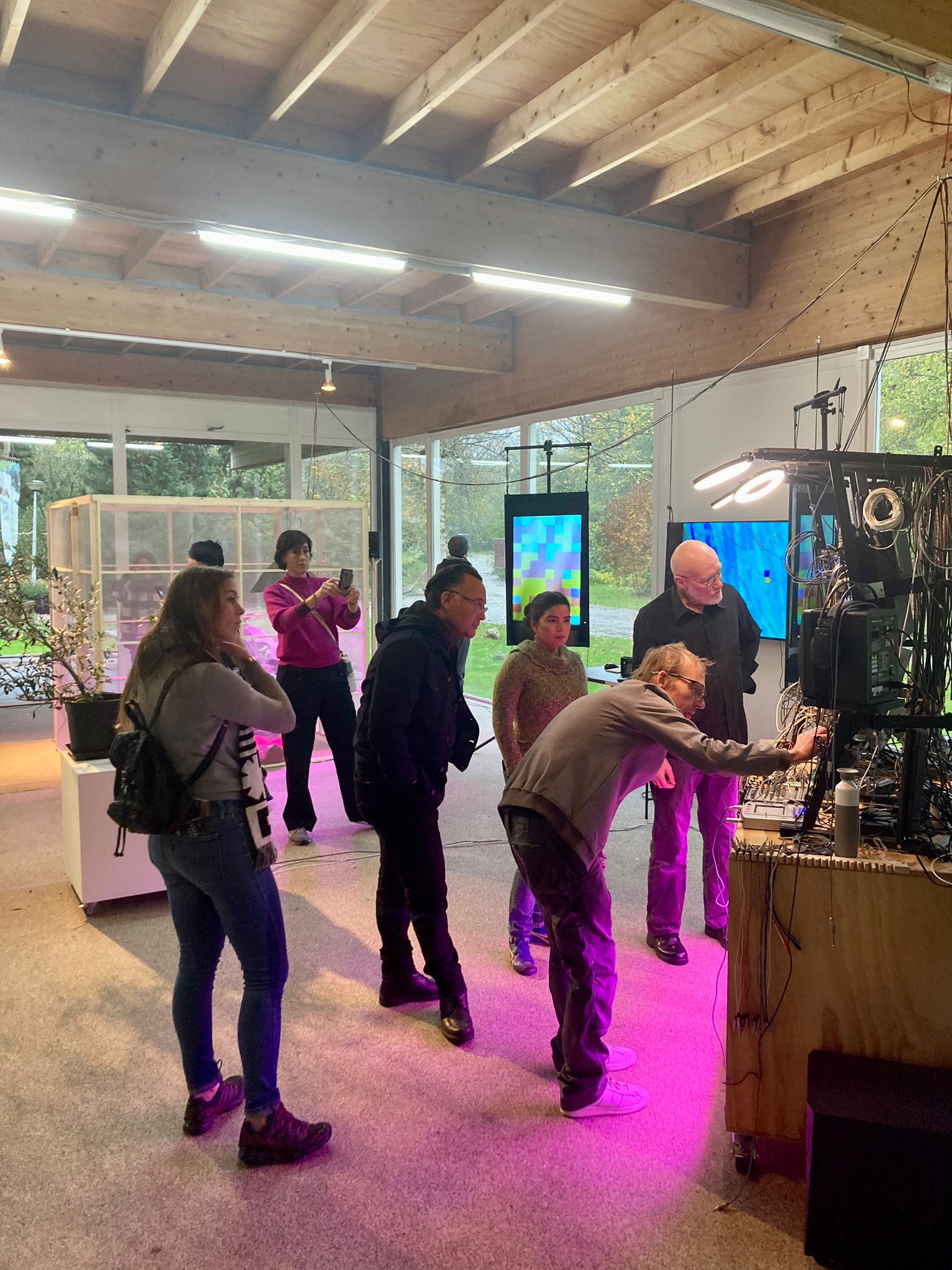This exhibition shows the results of the artistic research program Smart Hybrid Forms. Artists Špela Petrič and Christiaan Zwanikken have spent the past two years working as researchers at the ArtScience Lab Hybrid Forms at the VU University Amsterdam on creating projects in which they explore relationships between plant and machine.
Science is producing increasingly hybrid entities in which the biological and technological merge. Whereas this is usually seen as a move away from nature, in Smart Hybrid Forms we investigate these cyborgs as new actors for another, entangled world that appears as a result of climate change. The research focuses on the relationship between plants and technology, in which plants – with their very different but perhaps much more successful ways of existence – appear as the radical other that we might be able to access through technology. If the human has become a geological force, as the Anthropocene suggests, then the traditional method of science, which sees nature as an object of study that lies outside ourselves, can no longer be sustained. We need to tell new stories not only about human relationships with nature, but also about the way we produce knowledge and explore the world. The field of art-science in which Špela Petrič and Christiaan Zwanikken operate, explores other strategies of knowledge production and develops new tools to re-explore what it means to be human on a multi-species planet.
Christiaan Zwanikken presents his latest installation Excitation Station: a field laboratory for unusual experiments with plants and electronic equipment. For the past two years, Zwanikken has been investigating whether we can interact with plants by creating a sensor system that can increase our empathy for plants, as well as biodiversity in general. In the Smart Hybrid Forms art-science lab at the VU, he developed complex plant-human-machine interfaces and electronic “plant-feedback” circuits.
For the exhibition Smart Hybrid Forms, this equipment is connected to plants and trees in and outside het Glazen Huis in the Amstelpark. A unique property of this sensor equipment is that the ‘electrical sensory reactions’ of the plant become part of an electrical circuit in which the received signals, whether processed or not, can be returned. By making an electrical conversion to so-called CVs (control voltages), a modular synthesizer system is controlled that can generate complex sound structures in which the plant becomes the conductor. The sonorous result can also be sent back to the plant in a plant-sensory way. This creates an interaction between the plant and the equipment connected to it. Excitation Station will also showcase the latest development of using CVs to generate “biograms”. These are graphic, self-composing images created in real time by plant signals that are then presented on monitors.
Visitors to Excitation Station are invited to enter a small “Faraday meditation cage” – a room that is shielded from ambient electrical noise to prevent erroneous readings from the equipment. By touching the plant or only approaching it mentally, the visitor can become part of the plant’s sensory system and experience the interaction with the plant. Excitation Station invites us to speculate on the (extra)sensory capabilities of plants.
Špela Petrič developed the installation PL’AI for Smart Hybrid Forms – the third work from her opus The PlantMachine – which will be shown in its most recent form in this exhibition. PL’AI embraces the position that all living bodies – including plants – have the capacity to play. Unlike games that are limited by clear rules and goals, play is an ever-changing expression of freedom, which also reflects that all existence is relational. PL’AI is a process in which cucumber plants and an AI robot play with each other. This play beyond the human time scale promises a glimpse of artificial intelligence as formed by the plant and, conversely, a morphology of the plant imprinted by the interventions of the robot.
Whereas in agriculture vegetables are manipulated and controlled by sophisticated algorithms, the project explores the potential of using machine learning, artificial intelligence and robotics to propose alternatives to the limited view of plants as a living resource. It uses technology not for their exploitation but for their enjoyment – whatever that may be. At the same time, it raises the question of whether AI and machine learning tools are inescapably linked to utility and efficiency. PL’AI is thus an expression of biological and technological bodies in their shared desire to thrive.
In addition to PL’AI, Špela also shows video documentation of Performative Ethnographies: a collective research methodology that she developed for Smart Hybrid Forms and so far performed in a flower greenhouse, a hospital and a zoo (during the 3×3 at V2_ in Westland greenhouses and Erasmus hospital and as resident of Machine Wilderness organized by Zone2Source at Artis Royal Zoo). In Performative Ethnographies Špela remains, as philosopher Donna Haraway put it, ‘with the trouble’. Performative Ethnographies function as a form of public engagement that provides access to hidden infrastructures in order to understand their influence on power dynamics, behavior and social relationships. Participants go on an expedition with a local guide during which they take ethnographic notes and share their observations afterwards. Multiple perspectives on technologies of care unfold here. The exhibition shows videos of the three expeditions in which this performative methodology is put into practice, in places where care for different forms of life (people, animals and plants) is enacted.

This exhibition shows the results of the artistic research program Smart Hybrid Forms, a project of the Vrije Universiteit Amsterdam, Gerrit Rietveld Academy, Waag, V2_the lab for unstable media and Zone2Source. It received a NWO ISA Smart Cultures grant with project number CISC.KC.215.
The exhibition can be visited from Friday to Sunday between 12:00-16:00 at the Glazen Huis, Amstelpark, Amsterdam. Also on request.
During the Christmas holidays, we will be closed from December 23 through January 1.
The exhibition is accompanied by a program of lectures, discussions, workshops and demonstrations at Zone2Source and our partners V2_ and de Waag in which the artists show the processes of the research at various stages. Zone2Source director Alice Smits is also a researcher of the Rietveld Academy associated with the project for theoretical reflection, which will result in a publication in 2023.
Thursday October 27 – Test_Lab: Smart Hybrid Forms
19:30-22:30 at V2_ (Rotterdam)
By exploring plants’ sensory abilities under different conditions, natural and manipulated, these artists merge organic and inorganic systems to create new forms of intelligence. With an introductory conversation between Alice Smits (Zone2Source) and Raoul Frese (VU). Read more
Tuesday November 1 – “Tomato, Basil, Cucumber”
10:30-15:30 at Waag (Amsterdam)
An experimental symposium during which we will attempt to lay bare the multiple ways people know and understand the humble vegetable. Throughout the 5-hour guided session we will collectively contextualize the field of vegetable production while focusing on how different practices impact the ontology of produce: how do ways of relating to veggies change according to who/what is caring for them and how they are eaten? What are the political implications of salad production? What counter-cultural connotations can overtly technological relationships to these companion plants bring? Read more
Thursday November 3rd – Waag Open: Secret lives of plants
19:30-23:00 at Waag (Amsterdam)
Are you curious about the blurring distinctions between nature and culture? Come to Waag and experience with art-science artists Špela Petrič and Christiaan Zwanniken how plants communicate, not only amongst each other, but also with you. We start off with talks and then go into hands-on experiments. Read more
Sunday November 6: Opening Smart Hybrid Forms exhibition
Opening of the Smart Hybrid Forms exhibition at Zone2Source, Het Glazen Huis, 15.00 – 17.00
Finissage Smart Hybrid Forms
Featuring various talks and presentations by artists and project partners.
Date and times to be announced.

Christiaan Zwanikken is a Dutch artist, known for his kinetic sculptures and responsive installations. He has received international recognition for his kinetic and mechanical sculptures, sound works, performative and responsive installations. Using a variety of sculptural media, robotics, biology, microcontrollers and sound, his work is both an artistic and technological experiment in which innovation and invention play an important role. Zwanikken explores the relationship between man, nature, science and technology and allows the animate and the inanimate to merge. Although he uses “hard” technologies such as machines and control systems, he always tries to appeal to humans and “soft” technologies. His work has been presented in solo and group exhibition in amongst others het Museum of Natural History (NYC), Exit 2011 (Parijs), ISEA2012 (Albuquerque), Kinetica Museum (Londen), Museum Tingeuly (Bazel), Kunsthaus Graz (Oostenrijk), ICC Centre (Tokio), National Galerie (Praag), Taipei Fine Arts Museum (Taiwan), Museu del Chopo (Mexico-Stad) en Stedelijk Museum Amsterdam (Nederland).
Špela Petrič is a Ljubljana and Amsterdam based new media artist who is trained in natural sciences and holds a PhD in biology. In the past year she worked as a post-doc researcher at the Hybrid Forms Lab of the VU University Amsterdam. Her artistic practice combines natural sciences, biomedia practices and performance, and critically examines the limits of anthropocentrism through multi-species assemblages. She devises artistic experiments that forge strange relationships between biological and technological agents to expose the ontological and epistemological foundations of our (bio)technological societies. Petrič received several awards, such as the White Aphroid for outstanding artistic achievements (Slovenia), the Bioart and Design Award (Netherlands).
Read the exhibition brochure here.